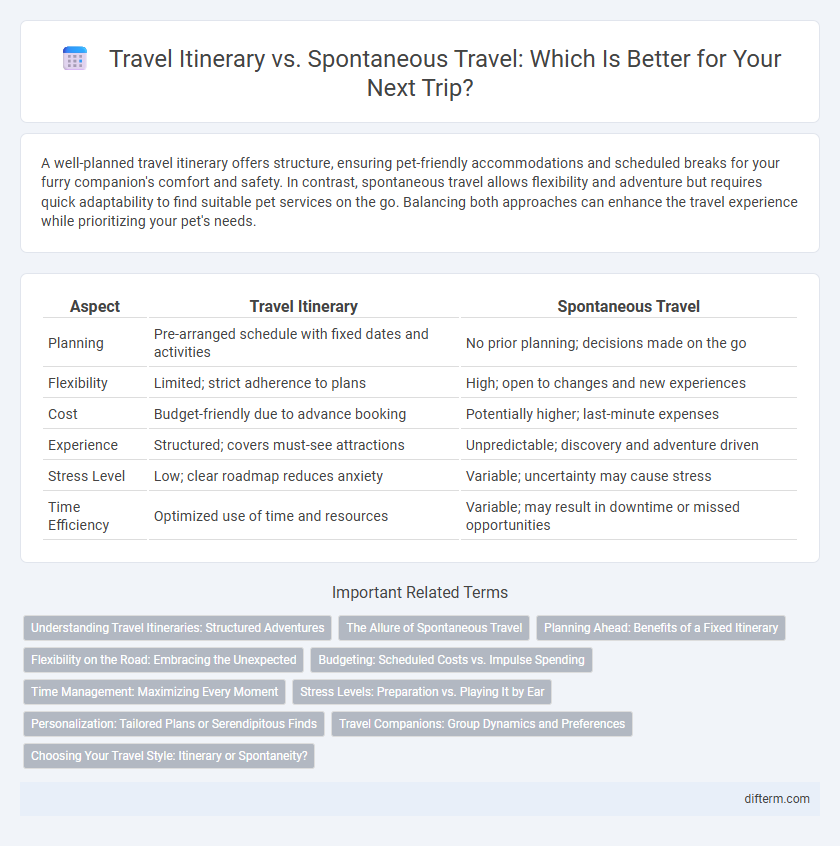A well-planned travel itinerary offers structure, ensuring pet-friendly accommodations and scheduled breaks for your furry companion's comfort and safety. In contrast, spontaneous travel allows flexibility and adventure but requires quick adaptability to find suitable pet services on the go. Balancing both approaches can enhance the travel experience while prioritizing your pet's needs.
Table of Comparison
| Aspect | Travel Itinerary | Spontaneous Travel |
|---|---|---|
| Planning | Pre-arranged schedule with fixed dates and activities | No prior planning; decisions made on the go |
| Flexibility | Limited; strict adherence to plans | High; open to changes and new experiences |
| Cost | Budget-friendly due to advance booking | Potentially higher; last-minute expenses |
| Experience | Structured; covers must-see attractions | Unpredictable; discovery and adventure driven |
| Stress Level | Low; clear roadmap reduces anxiety | Variable; uncertainty may cause stress |
| Time Efficiency | Optimized use of time and resources | Variable; may result in downtime or missed opportunities |
Understanding Travel Itineraries: Structured Adventures
Travel itineraries provide a detailed roadmap for exploring destinations, outlining daily activities, transportation, and accommodations to maximize efficiency and experience. Structured adventures through travel itineraries enable travelers to plan key attractions, cultural experiences, and dining options, reducing uncertainty and stress during the trip. This approach enhances time management and ensures that must-see landmarks and unique local experiences are prioritized for a fulfilling journey.
The Allure of Spontaneous Travel
Spontaneous travel captivates adventurers with its unpredictability, offering immersive experiences that rigid itineraries often miss. Travelers embracing spontaneity discover hidden gems, authentic local interactions, and a heightened sense of freedom that enriches their journey. This approach fuels creativity and personal growth, making each trip uniquely memorable without the constraints of pre-planned schedules.
Planning Ahead: Benefits of a Fixed Itinerary
Planning ahead with a fixed travel itinerary enables efficient time management, ensuring key attractions and activities are prioritized without last-minute stress. Booking accommodations and transportation in advance often results in cost savings and availability guarantees, enhancing the overall travel experience. A structured itinerary also allows for better budgeting and resource allocation, making trips more predictable and enjoyable.
Flexibility on the Road: Embracing the Unexpected
Travel itineraries offer structure and planned experiences, but spontaneous travel maximizes flexibility by allowing travelers to adapt to unforeseen opportunities and local insights. Embracing the unexpected on the road fosters authentic encounters and unique adventures, often missed when following a rigid schedule. Prioritizing open-ended exploration enhances cultural immersion and personal growth during any journey.
Budgeting: Scheduled Costs vs. Impulse Spending
Travel itineraries allow for precise budgeting by allocating funds to pre-planned activities, accommodations, and transportation, reducing the risk of unexpected expenses. Spontaneous travel often involves impulse spending on last-minute experiences, meals, or upgrades, which can lead to fluctuating and higher overall costs. Planning helps travelers maximize their budget efficiency, while unplanned trips embrace flexibility at the potential expense of financial control.
Time Management: Maximizing Every Moment
Travel itineraries provide structured schedules that allow travelers to allocate time efficiently, ensuring key attractions and activities are not missed. Spontaneous travel offers flexibility to adapt plans based on real-time preferences, but may risk underutilizing available time. Effective time management in travel balances planned events with open moments to maximize experiences without feeling rushed.
Stress Levels: Preparation vs. Playing It by Ear
Structured travel itineraries reduce stress by providing clear plans, confirmed accommodations, and scheduled activities, which minimize uncertainty and decision fatigue. Spontaneous travel increases stress levels due to unpredictability and last-minute problem-solving, but it offers flexibility and the thrill of unexpected discoveries. Travelers seeking low-stress experiences benefit from detailed planning, while those embracing adventure may tolerate higher stress for greater exploration freedom.
Personalization: Tailored Plans or Serendipitous Finds
Personalized travel itineraries leverage data-driven preferences to craft tailored experiences, ensuring visits to landmarks, dining, and activities match individual interests and time constraints. In contrast, spontaneous travel embraces serendipity, allowing unexpected discoveries and authentic encounters that often lie beyond curated plans. Balancing structured itineraries with flexibility maximizes unique cultural immersion and satisfaction for modern travelers.
Travel Companions: Group Dynamics and Preferences
Travel companions shape group dynamics and preferences, influencing whether a travel itinerary or spontaneous travel suits the journey better. Structured itineraries help accommodate diverse interests and ensure organized experiences for large groups, minimizing conflicts and maximizing shared enjoyment. In contrast, spontaneous travel allows close companions to adapt plans flexibly, fostering stronger bonds through shared discovery and collective decision-making.
Choosing Your Travel Style: Itinerary or Spontaneity?
Choosing between a travel itinerary and spontaneous travel depends on your preferences for structure and flexibility; itineraries offer organized plans with set accommodations and activities, ensuring efficient use of time and budget. Spontaneous travel allows for exploration and adaptability, embracing unexpected opportunities and local experiences that rigid schedules might miss. Balancing these styles can enhance your trip by combining the benefits of preparation with the excitement of discovery.
travel itinerary vs spontaneous travel Infographic

 difterm.com
difterm.com